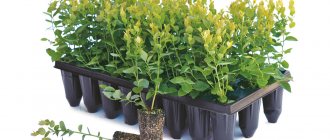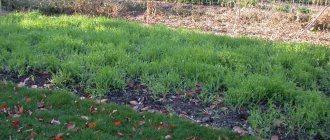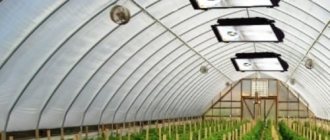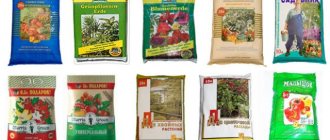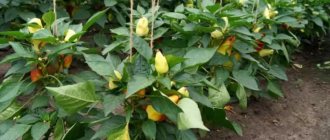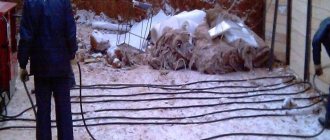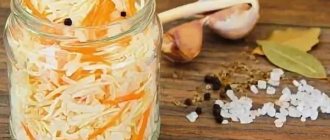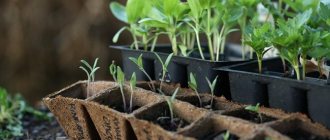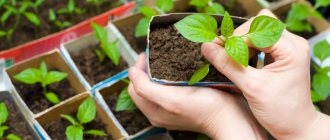Every year, in early spring, thousands of gardeners begin preparing for the new season. They plant various crops as seedlings, carefully look after them in order to get a good harvest, healthy and high-quality shoots, ready for planting in open ground.
At the same time, various questions and difficulties arise, for example, how to choose containers for seedlings and which ones are better. This is exactly what this article will discuss.
What is a cassette
Seedling cassettes are special containers for sowing seeds. These are individual containers fastened together, where each individual shoot grows separately from the others.
This method of sowing is considered the most convenient and practical. You can buy cassettes at any grocery or gardening store at a low price.
Cassettes for seedlings are presented in the form of blocks of various sizes, divided into individual containers with a volume of 20 to 500 ml. Most often you can find 4, 6 or 8 cassette blocks on the shelves.
The walls of the cassettes are dense, they do not allow the root systems of neighboring plants to touch, which allows you to get healthy and even shoots.
Not only the size of the cassette cells plays a big role, but also the material from which they are made
The most common on the shelves of gardening stores are the following:
- made of plastic;
- from pre-compacted cardboard and waste paper;
- made from peat - a natural material that decomposes in the soil.
The container is selected for each individual crop. It all depends on how deep and wide the plant grows.
Egg cartons
Cardboard and plastic egg boxes are useful for germinating tomato seeds. These are small containers; it is impossible to pour enough soil into them for large seedlings. At first, before picking, the seedlings will feel normal there. In cardboard boxes, you need to regularly water the crops and seedlings, and in plastic boxes, be sure to make holes for water drainage. Both types will require a pallet.
What to grow tomato seedlings in - in ready-made beautiful factory containers or in homemade containers - is not so important. The main thing is to provide the plants with care, which will allow you to enjoy delicious ripe fruits by the end of the season.
Is it worth buying seedling cassettes?
Is it worth buying seedling cassettes? Here each gardener makes his own decision. In fact, they are very practical and easy to use.
Here, each seed is placed in an individual container, so subsequently young plants do not need to be picked or planted in separate jars
There are other significant advantages of using it. Let's take a closer look at them.
Pros when using
To date, seedling cassettes are widely popular among gardeners. This is explained by a large list of advantages, which include:
- Each seed is placed in an individual compartment of the cassette and grows in it until transplanted into open ground; no replanting is required. This is especially good for plants with a weak root system, the replanting of which in most cases ends in the death of young shoots.
- Additional lighting. As a rule, seedlings begin to be planted in late winter - early spring. During this period, most regions of Russia experience increased cloudiness, all days are mostly cloudy, and the sun rarely comes out for long. This is detrimental to the seeds because they require sufficient amounts of solar energy to germinate. So, it is convenient to place seedling cassettes under ultraviolet lamps.
- An abundance of shapes and sizes of cassettes. For each individual crop, you can choose your own container, from which it will later be more convenient to transplant young shoots into open ground.
- Each cassette has drainage holes to help remove excess moisture. This will protect the plant, in particular its root system, from rotting.
- Convenience of placement. Typically, gardeners use disposable plastic cups for seedlings. They are very inconvenient, unstable, and require a fairly large space on the windowsill. The same cannot be said about compact cassettes.
- It is convenient to move seedlings in cassettes and take them outside for hardening.
- The cassettes can be separated by simply cutting off the required ones with scissors. For example, you can remove unhealthy shoots or seeds that have not sprouted.
Cassettes for seedlings help save soil mixture.
They are, as a rule, shallow, but this size is sufficient for normal growth and development of shoots. All of the listed advantages indicate that every gardener should purchase cassettes, since they greatly simplify the process of growing seedlings.
But at the same time, there are also disadvantages that you also need to be aware of.
Flaws
Along with the advantages, it is necessary to consider the disadvantages of seedling trays. These include:
- The need for constant watering. As already mentioned, the cassettes are produced at a shallow depth, so the volume of soil dries out quickly.
- It is unprofitable for large volumes, since you will need to purchase a fairly large number of seedling cassettes. If the containers are plastic, they can be left for next year if used carefully. And peat or paper ones will have to be purchased every season.
- Containers require additional disinfection.
- An incorrectly selected cell size will result in young seedlings not having enough space to grow and develop, so they may wither.
Products that are too cheap are usually made from low-quality plastic, which can be toxic
For planting, it is necessary to use only high-quality cassettes and select them according to the size of the crops being planted.
Small table with seating box
Let's consider another option - this time we are talking about a table, compact and very convenient. As the weather warms up, this table can be placed on the veranda. The manufacturing process itself is not complicated. If you look at the images below, you will understand everything yourself.
Table with box for seedlings
Making a table
Diagram of the seedling box itself
Assembling the box
The box is ready, now it needs to be placed on the table
Features of cassette growing
The cassette growing method has its own distinctive features. And, if the choice is on this method, you need to study them in order to get good young shoots ready for transplanting to open ground:
- fill the cassettes with light porous soil. Usually the soil is sifted through a sieve before planting;
- plants in cassettes must be watered with a growth stimulator or special vitamin complexes;
- in order to increase seed germination, it is recommended to cover the cassettes with a plastic bag or film to create a greenhouse effect;
- It is recommended to place the cassettes in a warm, sunny place where the temperature is about 20-22°C - this is normal room temperature.
After about 40-60 days, the seedlings are ready for transplanting into open ground. The exact date can be seen on the seed packaging
The experience of gardeners shows that when growing seedlings in cassettes, about 95-97% of the seed germinates. And with the usual method, this figure is only 75-80%. This is another reason why the cassette method is popular.
Basic requirements for seedling boxes
The most important thing is that the boxes are suitable for the crop that you intend to grow in them. And if the containers are too large/small, they will most likely interfere with the normal development of the seedlings.
Requirements for a seedling box
Boxes sold in specialized stores have the following disadvantages:
- high price;
- thermal conductivity unsuitable for home use;
- the need to wash after each use;
- transparent walls (the roots are not protected from ultraviolet radiation);
- the bottom “walks” at the slightest careless movement and breaks off thin seedling roots (if the root is damaged, the sprout will simply die);
- drainage holes are too large or absent as such.
Homemade seedling boxes are much better in quality than store-bought ones
And if we take into account all these negative qualities, it becomes obvious why gardeners today still make seedling boxes with their own hands. Despite the fact that the times of shortages are a thing of the past.
What can you grow?
The cassette method of growing seedlings is very popular among gardeners. And, above all, due to the fact that it is suitable for almost all types of crops:
- any flowering plants;
- tomatoes;
- cucumbers;
- squash;
- cabbage;
- zucchini;
- bell or green pepper;
- strawberries and garden strawberries;
- radish.
Moreover, you can plant not only seeds, but also cuttings and bulbs
It turns out that the cassette method is suitable for all methods of plant propagation.
Quality check
When buying cassettes for seedlings, you need to be extremely attentive to the product. The quality of the harvest largely depends on this. To select the right container, it is recommended to follow these recommendations:
- It is advisable that the disembarkation cassettes be packed in sealed vacuum packaging. It must be intact, without damage or defects. It is better not to take a product with damaged packaging, since in this case the storage rules were violated;
- The cassettes should be made of dense material and hold their shape well. In addition, they should be predominantly made from natural ingredients. Toxic components can negatively affect young seedlings;
- It is better to take medium-sized cassettes, not too deep. They are ideal for various crops.
Instructions from the manufacturer should be included with the seedling cassettes. It is also recommended to study it carefully, since each product has its own individual characteristics.
Size matters
Cassettes for seedlings differ primarily in the material from which they are made. But there is another classification - according to overall dimensions and number of cells.
For different crops, individual containers are selected based on depth and wall thickness.
For most plants, medium-sized containers are suitable, but there are exceptions:
- It is recommended to plant early cabbage, strawberries, tomatoes and cucumbers in cells with a volume of up to 70 ml;
- sweet peppers - into cone-shaped deep containers with a volume of up to 40 ml.
For greens, dill and parsley, leeks, onions, herbs, late cabbage, cells of the smallest volume are used.
Some manufacturers offer a line of cassettes for each type of crop. They develop special tables from which the gardener can understand which type of cells is most suitable.
In general, the principle is as follows: if the plant has a developed root system that goes deep, then select narrow and deep containers. If the root system develops predominantly in breadth - shallow but wide cells.
Which seedling cassettes are better?
Nowadays, there are three main types of seedling trays that are most common:
- plastic, made of PVC or polystyrene. They are usually reusable and can be used for several seasons in a row;
- peat or biodegradable. They are used for one season. Plants from them are not transplanted into open ground, but are planted together with cells, since peat quickly decomposes in the soil, turning into a natural fertilizer;
- paper ones are another eco-friendly option, but they can only be used for one season. They are made of thick cardboard or waste paper, non-toxic and safe for plants.
Let's take a closer look at each type.
Plastic
As already mentioned, plastic cassettes are made of dense material PVC or polystyrene .
You can find out what type of plastic they are made from by the corresponding markings on the bottom of the container. It is recommended to choose cassettes made of biodegradable plastic, since it is less toxic and less dangerous for the environment, and does not have a pungent, toxic odor.
Plastic cassettes have the following advantages:
- a variety of sizes and shapes, which allows you to select an individual container for each garden crop;
- easy to use: they can be cut, moved, arranged as convenient;
- there are drainage holes at the bottom and a tray to collect excess moisture;
- no picking of young shoots is required, since each seed is initially planted in an individual container;
- the death of the plant in case of transplantation due to damage to the root system is excluded;
- durability: they last about 3-5 years, they can be washed and stored.
The cassettes usually come with a tray on which they can be placed. With its help, you can transfer seedlings, take them under ultraviolet lamps or outside for hardening. There may also be a special cover that replaces the film to create a greenhouse effect.
Paper
Paper cassettes are also used for growing seedlings. They are produced in a single block of 4, 6, 8 or 10 cells. They are very convenient to use, especially when transplanting: the container is easily cut with scissors, and the young shoot is removed along with a lump of surrounding earth.
Some manufacturers produce paper-peat containers that can decompose in the soil of a vegetable garden or garden under the influence of air, moisture, sunlight and the action of microorganisms.
But you should know that when paper decomposes, it displaces nitrogenous substances from the soil, so additional feeding is required with fertilizers containing this microelement. Urea is ideal.
The disadvantages of these cassettes include the following points:
- The need to buy cassettes every year;
- With an abundance of moisture, the walls of the cells soften, they can become moldy and infect young shoots with fungus, which will make transplanting to open ground impossible.
Paper seedling cassettes are rarely used for seedlings; peat containers are usually preferred.
Peat
Peat cassettes are made from peat - a natural material that decomposes in soil under the influence of moisture, bacteria, sunlight and oxygen. It turns out that the roots of young shoots receive additional fertilizer during the period of active growth on the soil.
Peat cassettes for seedlings have the following advantages:
- natural material that does not contain harmful additives and is absolutely safe for the environment;
- the walls of the cassettes allow air to pass through well, which will prevent rotting and diseases of the root system;
- no picking of young shoots is required, which completely eliminates the death of the plant during transplantation due to damage to the root system;
- low cost compared to previous options.
Peat trays for seedlings
When growing seedlings in peat trays, it is necessary to carefully monitor watering. An abundance of moisture can lead to soaking of the walls, and a lack of moisture can lead to drying out of the earthen clod.
As in the case of paper cassettes, peat cassettes take nitrogen from the soil when decomposing, so fertilizing is required.
How to use cassettes
In order for the seedlings in the cassettes to be healthy and suitable for transplanting to open ground, it is necessary to follow some recommendations regarding the selection of the cells themselves, the soil, care and watering, and maintaining the light regime:
- the soil should be light, loose, but nutritious, containing all the necessary components for the growth of garden crops. You can find ready-made substrate in gardening stores;
- apply fertilizer against fungi and bacterial plant diseases;
- Before planting, the seeds are soaked in a weak solution of potassium permanganate or a special growth stimulator.
It is necessary to place seedlings in a warm, illuminated place or under ultraviolet lamps.
How to plant seedlings in cassettes? The sequence of actions is as follows:
- Fill the cells 2/3 with soil.
- Level the surface and spray with water from a spray bottle. It is advisable to use warm water at room temperature.
- Place seeds on top of the soil.
- Sprinkle the seeds with soil in a layer of 5-7 millimeters.
- Spray the surface again with water from a spray bottle.
- If the seeds are large enough, they need to be buried in the ground and only then covered with soil.
- Cover the cassettes with film or a special lid to create a greenhouse effect. Place them in a warm sunny place. A window sill on the south or southwest side is ideal.
- Open the film or lid every day to remove condensation. Water as needed.
- After seed germination, the lid is removed, but the cassettes are still left in a warm, sunny place.
- A week and a half after the seeds have sprouted, it is recommended to add mineral fertilizer to the soil.
As you can see, the rules for planting in cassettes are practically no different from planting in ordinary containers or cups.
PVC or polystyrene containers
Plastic containers can usually be purchased as a set, which includes a tray and individual or connected pots. They must have holes for water drainage. You can find sets with a lid, real miniature greenhouses. They are very convenient; you do not have to cover the crops with film or glass until shoots emerge.
Containers make it easy to transport seedlings to the dacha; plants with a clump can be quickly removed from separate containers and injuries to the root system can be minimized. Cassettes are less convenient; it is more difficult to remove plants from them, because You cannot turn each container over individually. Ready-made containers are very practical, but if you grow a lot of seedlings, then purchasing them can be quite hard on your wallet. Costs can only be offset by repeated use of these devices.
Features of caring for seedlings in cassettes
Caring for seedlings in cassettes is completely ordinary:
- water the shoots as needed so that the soil does not dry out, but also does not become waterlogged;
- cassettes are kept in a warm place or under ultraviolet lamps;
- as it grows, it is recommended to add fertilizers to the soil, for example, “Aquarin”, “Kalimag”, “Plantafol”, “Kristalon”, “Kemiroy” (“Fertika”), “Ammofos”, “Signor Tomato”, “Stimul” and “ Azofoska."
30-40 days after seed germination, young shoots can be taken outside for several hours for hardening.
Following these rules will allow you to grow healthy and good seedlings.
Plastic bottles
Regular plastic bottles with a volume of 1-1.5 liters are suitable for making a mini-greenhouse or an individual pot. You need to remove the middle part of the bottle. The lower part, 8-10 cm high, will serve as a pot, and the top with the neck will serve as a lid for the greenhouse. Holes for drainage must be made in the bottom. The lid of such a greenhouse can be made removable or hinged by securing it to the bottom with adhesive tape. To ventilate, simply remove the plug.
A plastic bottle works great as a seed germination tray. The bottle is cut lengthwise, the halves are placed on their sides and filled with soil. The tomato can be sown in such a tray and kept in it until picking. It is important to make holes in plastic containers to allow water to drain. It is advisable to wrap transparent bottles with thick paper or foil to prevent blue-green algae from multiplying in the soil in the light.
Estimated cost
In gardening stores you can find various cassettes for seedlings. They differ, as already mentioned, in material, depth and number of cells. Based on this, the cost also varies:
- cassette for 8 cells - about 10 rubles;
- cassette for 24 cells - about 30 rubles;
- cassette for 50 cells - about 50 rubles;
- cassette for 100 cells - about 70 rubles;
- cassette for a larger number of cells - over 80 rubles.
Cassettes can be domestic or foreign made. The latter, of course, are more expensive, but they are practically the same in quality.
